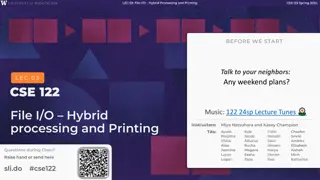
Digital Communications in CTE Department - 3rd Stage
Explore the fundamentals and applications of Digital Communications in the CTE Department - 3rd Stage, focusing on topics like intersymbol interference, baseband transmission, and equalization. Learn about combating ISI and improving signal quality through proper filter design.
Download Presentation

Please find below an Image/Link to download the presentation.
The content on the website is provided AS IS for your information and personal use only. It may not be sold, licensed, or shared on other websites without obtaining consent from the author. If you encounter any issues during the download, it is possible that the publisher has removed the file from their server.
You are allowed to download the files provided on this website for personal or commercial use, subject to the condition that they are used lawfully. All files are the property of their respective owners.
The content on the website is provided AS IS for your information and personal use only. It may not be sold, licensed, or shared on other websites without obtaining consent from the author.
E N D
Presentation Transcript
. : 2- 2018-2019 Digital Communications CTE Department -3rdstage Reference: Digital Communications Fundamentalsand Applications, 2nd Addition, byFernardSklar Dr. Hussam Dheaa Kamel Al-Mustafa University Collage CTE Department 2018-2019
CTE Department -3rdstage Digital Communications 3- Intersymbol Interference (ISI): ISI arises because dispersive nature of the communication channel, thus the errors are introduced in the detected data at the receiver. The binary data can be transmitted in baseband or passband. One of the baseband system of digital data is PAM which is have only two amplitude level corresponding to binary "1" and "0". Successive binary digits can combined into symbol. Line codes generate discrete PAM signals which transmitted in baseband form (without any modulation) over the channel. Fig. 5 shows the block diagram of such baseband transmission system. Figure 15 The binary data (bk) is applied to the data encoder which generate the pulse waveform x(t) represented mathematically by: ?(?) = ???(? ???) ?= ??is the duration of each input binarybit. ?(?) is the shaping pulse. 2
CTE Department -3rdstage Digital Communications +? ? ?? ??= 1 ?? ??= 0 And ??= { The signal x(t) is then passed through the transmitting filter which combine all the necessary transmitting circuits and systems with transfer function of HT(f). The signal is then passed through the channel having transfer function HC(f). The channel delivers the signal to the receiving filter which combine all the necessary receiving circuits and systems with transfer function of HR(f). The output of the receiving filter is y(t) is a noisy replica of the transmitted signal x(t). The signal y(t) is then sampled synchronously with clock pulse at the transmitter having sampling instants ? = ???. The sampled signal y(ti) is then given to decision device which compare the input signal with threshold "?": If y(ti) ? select symbol '1' If y(ti) ? select symbol '0' ISI Problem: Consider the output y(t) of the receiving filter represented by: ?(?) = ???(? ???) ?= Here is scaling factor and P(t) is the different from that of g(t) We have ? = ???then: ?(?) = ???(??? ???) ?= 3
CTE Department -3rdstage Digital Communications ?(?) = ???(? ?)?? ?= Let us rearrange above equation: ?(?) = ???(0) + ???(? ?)?? ?= ? ? ??? ? = 0, 1, 2, 3, . If ISI is absent then the second term of above equation will not be present, and p(t) is normalized such that ?(0) = 0 yelds: ?(?) = ??. At ? = ???, the correct bit is ??. Observe that it is decoded correctly in absence of ISI, but it is not possible to eliminate the second term totally. The ISI can be reduced by proper design of transmitted filter HT(f), receive filter HR(f), and channel filter HC(f). 4
CTE Department -3rdstage Digital Communications Equalization: Figure4 Fig. 5 shows tapped delay line filter. The output of such filter is given as: ? 1 ?(??) = ??? (?? ??) ?=0 Here wiis the weight of ithtap, M is the total number of taps and T is the symbol duration of the signal. 5
CTE Department -3rdstage Digital Communications Figure 5 The weights are basically filter coefficients. This filter approximates the equalizer transfer function of above equation. The approximation will be more accurate if we use more tape in filter. Adaptive Equalizer: The transmission characteristic of the channel keep in changing. Hence adaptive equalization is used. In adaptive equalization, the filters adapt themselves to the dispersive effects of the channel. That is the coefficients of the filters are changed continuously according to the received data. The adaptive equalizer is a tapped delay-line filter. It consist of set of delay elements and variable multipliers. The sequence ?(??) is applied to the input of adaptive filter. The output ?(??) of the adaptive filter will be, 6
CTE Department -3rdstage Digital Communications ? ?(??) = ??? (?? ??) ?=0 The weights ??on the taps are basically adaptive filter coefficients. A known sequence {?(??)} is transmitted first. This sequence is known to the receiver. The error between two sequences is calculated: ?(??) = ?(??) ?(??), ? = 0,1,2, ..? 1 7
CTE Department -3rdstage Digital Communications The weights of the filter are changed recursively such that error ?(??) is minimized. There are standard algorithms to change weights of filter recursively. One of important algorithm is Least Mean Square (LMS) Algorithm. The tap weights are adapted by this algorithm as follows: ? ?(?? + ?) = ? ?(??) + ??(??)?(?? ??) ? = 0, 1, ? 1 ? ?(??) is the present estimate for tap ? at timenT, ? ?(?? + ?) is the updated estimate for tap ? at time nT, ? is the adaption constant, ?(?? ??) is the filter input and ?(??) is the error signal. In this algorithm initial tap weights are assumed zero. The MatchedFilter: A matched filter is a linear filter designed to provide the maximum signal to noise ratio at its output for a given transmitted symbol waveform. Consider that a known signal s(t) plus AWGN n(t) is the input to a linear time- invariant (receiving filter followed by a ? sampler. The ratio of instantaneous signal power to average noise power, (?)?, at time ? = ?, out of sampleris ?2 ?2 (? ?)?=? 0 We can express the signal ??(?) at the filter output in terms of filter transfer function: ?(?)?(?)??2????? ??(?) = 8
CTE Department -3rdstage Digital Communications Where ?(?) is the Fourier transform of input signal, ?(?). If the two sided power spectral density of the input is?0watts/hertz, then we can express the output noise poweras: 2 ?0 2 2 |2 ?(?) ?? | ? = 0 Substitute in the first equation: | ?(?)?(?)??2?????|2 ?0 2 ? ? ( )?= |?(?)|2?? Using Schwarz'sinequality: 2 | ?(?)?(?)??2?????| |?(?)|2?? |?(?)|2?? yields ? 2 ?0 |2 ?(?) ?? | ( )? = ? ???( ?) =2? ?? ?? ?0 Where the energy E of the input signals(t)is |?(?)|2?? ? = ? Thus the maximum output (?)?depends on the input signal energy and the and the power spectral density of the noise, not on the particular shape of the waveform that used. ???(?)?holds only if the optimum filter transfer function ?0(?) isemployed: ? 9
CTE Department -3rdstage Digital Communications ?(?) = ?0(?) = ?? (?)??2??? Or (?) = ???{ ?? (?)? ?2???} Since s(t) is a real valued signal, (?) = {??(? ?) 0 ? ? ????? ??? 0 Thus, the impulse response of a filter that produces the maximum output signal to noise ratio is the mirror image of the message signal s(t) delayed by the symbol time duration T. 10



![Lec [2] Health promotion](/thumb/274962/lec-2-health-promotion-powerpoint-ppt-presentation.jpg)